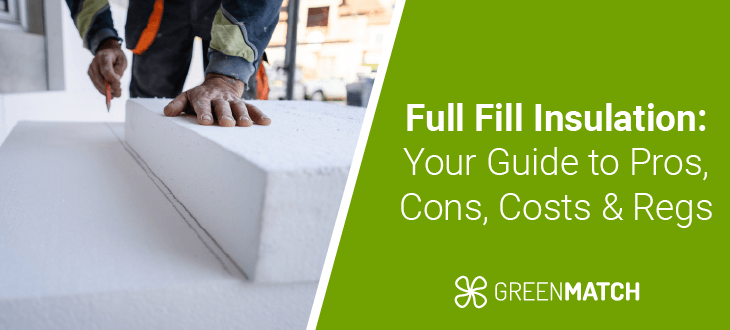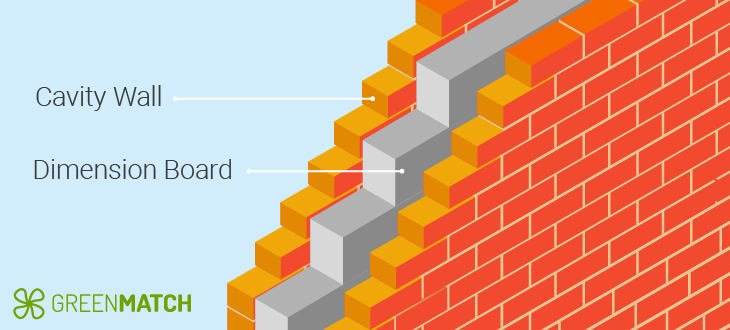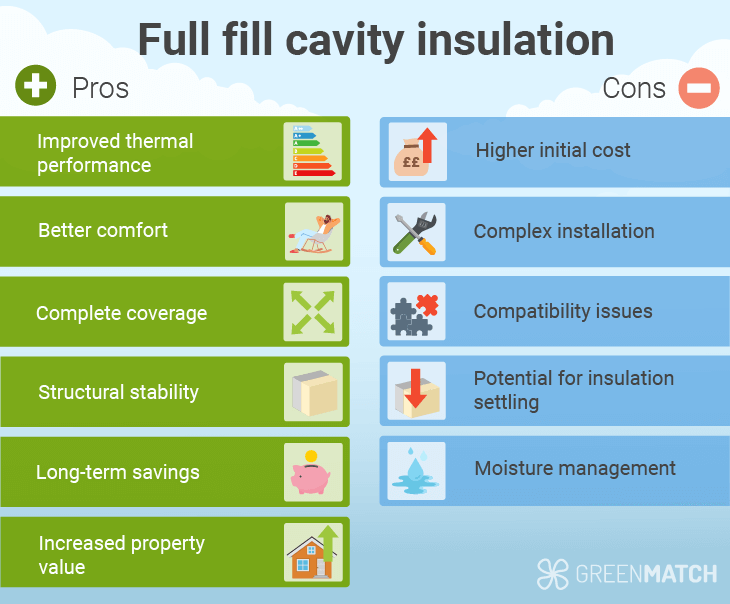Answer these simple questions and we will find you the BEST prices
Which type of solar quotes do you need?
It only takes 30 seconds
100% free with no obligation

Get Free quotes from insulation specialists near you

Save money by comparing quotes and choosing the most competitive offer

The service is 100% free and with no obligation
- GreenMatch
- Insulation
- Wall Insulation
- Cavity Wall Insulation
- Full Fill Insulation
Full Fill Insulation: Your Guide to Pros, Cons, Costs & Regs


- Houses built in the UK after the 1920s are most likely constructed with cavity walls.
- Full fill cavity insulation offers superior energy efficiency benefits by eliminating air gaps, reducing heat loss, and lowering energy consumption and costs. It also maintains a more consistent indoor temperature.
- The UK government strongly advocates using full fill insulation in homes and offers financial support through the ECO3 Scheme.
This guide will help you understand full fill insulation, including its advantages, potential drawbacks, costs, and regulations. Whether you're choosing insulation for your home or staying informed about industry standards, let's explore the pros, cons, price, and rules of full fill insulation together to make informed decisions about your insulation needs.
Thinking about insulating your home? Let Green Match streamline the entire process. Say goodbye to endless online searches and appointment arrangements – just fill out our quick online form in just 30 seconds. You'll receive up to 3 free quotes from trusted installers in your vicinity. Take the first step now by clicking the button below!
Fill in the form in just 1 minute
- What is full fill cavity insulation?
- Full fill cavity insulation vs partial fill
- Pros and cons of full fill cavity insulation
- Building regulations for full fill cavity wall insulation
- Best materials for full fill cavity wall insulation
- Full fill cavity insulation cost in the UK
- Is full fill cavity wall insulation an option for you?
- Compare quotes and find the best deal on full fill insulation
- FAQ
What is full fill cavity insulation?

Full fill insulation is a highly effective method for cavity walls. This technique involves filling the cavity between the inner and outer walls with a dimension board (450mm/455mm), securing no gaps or voids. Full fill insulation on a cavity wall creates an unbroken thermal barrier that improves the building's energy efficiency. To achieve optimal performance, it is important to follow specific installation techniques. This includes using insulation materials that precisely fit the cavity dimensions and offer high thermal resistance.
One key benefit of full fill insulation is that it effectively eliminates potential pathways for heat transfer and minimises air infiltration. This results in a significant improvement in energy efficiency, making it a highly desirable method for insulating cavity walls.
Full fill cavity insulation vs partial fill

When choosing between full fill and partial fill cavity insulation, weighing the differences in installation, cost, and effectiveness is crucial. Partial fill cavity insulation is easier and quicker to install, making it more cost-effective due to reduced material and labour requirements. However, it leaves a gap between the insulation and masonry, leading to air gaps and decreasing overall insulation effectiveness. These gaps can result in heat transfer and air infiltration, reducing energy efficiency.
On the other hand, full fill insulation fills the cavity, eliminating gaps and creating a continuous thermal barrier. Although this method is more expensive and requires careful installation, it significantly enhances insulation effectiveness and energy efficiency. While partial-fill insulation offers a cost-effective installation, full fill insulation provides superior thermal performance and long-term benefits.
Do you need cavity closers with full fill insulation?
Cavity closers are still necessary with full fill insulation, as they prevent heat loss, moisture penetration, and mould growth around doors and windows. Using cavity closers with full fill insulation is essential for maximising energy efficiency and ensuring the overall integrity of the insulated cavity wall.
Pros and cons of full fill cavity insulation

Full fill cavity insulation is popular among homeowners who want to improve their homes' energy efficiency and comfort. Although it provides various advantages, full fill cavity insulation problems can occur.
Pros
- Improved thermal performance: full fill insulation maximises energy efficiency by creating a continuous thermal barrier, keeping heat in during winter and out during summer.
- Better comfort: insulating the cavity with full fill insulation eliminates drafts and cold spots, maintaining a consistent and comfortable indoor temperature throughout the year.
- Complete coverage: full fill insulation assures that there are no gaps or voids within the cavity. This total coverage maximises the effectiveness of insulation and guarantees that the building envelope is well-sealed against the elements.
- Structural stability: full fill insulation plays an important role in improving the structural stability of the wall. It provides additional support and helps to reduce the risk of movement or settling, resulting in a more reliable and durable construction.
- Long-term savings: although the initial cost is higher, full fill insulation can significantly reduce energy bills. Its superior insulating properties lessen the workload on heating and cooling systems, leading to decreased energy consumption and costs.
- Increased property value: homes with high-quality insulation often appeal more to buyers. Full fill insulation also aids in meeting building regulations and improving a property's SAP (Standard Assessment Procedure) rating.
Cons
- Higher initial cost: one of the main downsides of full fill cavity insulation is the higher initial cost. This type of insulation is more expensive because it requires a greater amount of material and is labour-intensive to install. This can be an important concern for homeowners with a limited budget.
- Complex installation: installing full-fill insulation requires careful attention to detail to ensure the cavity is filled without any gaps. Achieving this level of precision often requires professional installation by cavity wall insulation companies, which increases the overall cost and emphasises the importance of expertise in ensuring the effectiveness of the insulation. As a result, it is less suitable for DIY projects.
- Compatibility issues: some cavity walls, especially in older buildings with irregular or narrow cavities, may not be suitable for full fill insulation. In such cases, alternative insulation methods might be more appropriate and effective.
- Potential for insulation settling: the insulation material used in full fill cavity insulation can settle or degrade over time, leading to voids or gaps in the insulation layer, reducing its effectiveness.
- Moisture management: full fill insulation effectively controls moisture but requires proper cavity wall insulation installation and protection from external moisture sources to prevent dampness, mould growth, and insulation problems.
Building regulations for full fill cavity wall insulation

The regulations for full fill cavity wall insulation are designed to provide flexibility while providing specific recommendations and requirements to guarantee optimal insulation performance and maintain the structural integrity of the building:
Recommended U-Value requirement
Insulation efficiency is measured by its "U-value" in building regulations. This value indicates the heat loss or gain rate and is expressed in watts per square metre per Kelvin (W/m2k). Lower "U-values" indicate better insulation performance. Insulation is recommended to have a 0.18W/m2K u-value.
Limitations on cavity size and wall construction
Building regulations may limit full fill cavity insulation based on cavity size and wall construction. For example, very narrow cavities may not be suitable for full fill insulation, as the cavity width should be at least 50mm. Most standard regulations require cavity widths of 100mm to 150mm, and the insulation installed should be at least 270mm thick.
Regional considerations
Building regulations regarding insulation values may vary slightly in England, Scotland, Wales, and Northern Ireland. In some regions of the country, filled cavity wall insulation might not be recommended due to the risk of moisture penetration. Regions with high rainfall or coastal areas exposed to wind-driven rain are especially vulnerable to moisture ingress, making full fill insulation less suitable.
We recommend checking your government's website for more detailed information.
Compliance with thermal performance
Materials selected for full fill cavity insulation should be carefully chosen to ensure compliance with the current UK building regulations for thermal performance. These regulations guarantee that the insulation meets the minimum standards for energy efficiency, helping to improve the overall thermal performance of the building.
Best materials for full fill cavity wall insulation
When selecting the suitable material for full fill cavity wall insulation, it's crucial to consider options with superior thermal performance and a perfect fit for this specific application. Here are some of the best materials that meet these criteria:
Mineral wool insulation
Mineral Wool Insulation such as rock or glass wool is recognized for its high thermal resistance and fire-retardant properties. It efficiently fills the cavity, providing excellent sound and thermal insulation. Mineral wool is also non-combustible, making it a safe choice for cavity wall applications. This material cost on average £25 – £30 per m2.
Phenolic core insulation
Phenolic Core Insulation or phenolic foam, is an excellent choice for thermal performance and fire resistance. Its high R-value per inch of thickness makes it one of the most efficient insulation materials available. Its lightweight yet rigid structure and outstanding moisture resistance make it suitable for full fill cavity wall insulation in various environments. It costs on average £10 per m2.
Polyisocyanurate core insulation (PIR)
Polyisocyanurate core (PIR) insulation is a proven choice for full fill cavity wall insulation. It provides superior thermal efficiency and fire resistance. With a closed-cell structure, full fill PIR cavity insulation offers excellent moisture resistance and dimensional stability. PIR insulation boards are lightweight and easy to install, making them popular cavity wall insulation in new build properties. This material costs on average £5 – £15 per m2.
Hemp wool insulation
Hemp full fill insulation is a sustainable and environmentally friendly insulation material made from the fibres of the hemp plant. It is a renewable resource that requires minimal water and no pesticides to grow, making it an eco-friendly choice for insulation. Hemp offers excellent thermal and acoustic properties, effectively keeping homes warm in the winter and cool in the summer while also reducing outside noise. It costs an average of £20 to £40.
When choosing the most suitable material for full fill cavity wall insulation in a particular project, extensive research and consideration of factors such as climate, building design, budget, and local building regulations are crucial. Asking for advice from insulation professionals can also offer valuable insights and personalised recommendations to meet the project's specific needs.
Full fill cavity insulation cost in the UK
When considering full fill cavity insulation in the UK, it's important to note that the typical cost ranges from £475 to £800. However, this cost can vary based on the size of the property. For example, a small flat may cost around £350, while a larger detached house can cost up to £1,500. Several factors influence the cost, including the type of insulation material, installation expenses, and the property size. It's advised to request quotes from multiple providers before deciding to guarantee you get the best value for your investment.
| Property type | Average price |
|---|---|
| Mid Floor Flat | £300-£500 |
| Detached Bungalow | £450-£650 |
| Semi-detached | £500-£700 |
| Detached | £700-£1,000 |
| Terraced | £350-£550 |
Is full fill cavity wall insulation an option for you?
Deciding whether full fill cavity wall insulation suits your property depends on several factors that require careful consideration. Firstly, your property must have cavity walls, as full fill insulation is specifically designed for this type of construction. Additionally, it's essential to balance your insulation needs with other factors such as budget, building regulations, and regional considerations.
Although full fill cavity wall insulation offers numerous advantages, it's important to consider potential limitations. Due to the risk of moisture penetration, it may not be advisable in regions with high rainfall or wind-driven rain. Evaluating your location's climate and any local regulations or recommendations is crucial before opting for full fill insulation.
Finally, the decision to use full fill cavity wall insulation should be made after carefully considering your specific needs and circumstances. Seeking advice from insulation professionals can provide valuable insights and help you determine the best insulation solution for your property.
Compare quotes and find the best deal on full fill insulation
Considering insulating your home? Let GreenMatch handle the hard work for you. Skip the hours of online research and appointment scheduling – just fill out our quick online form in 30 seconds. You'll then receive up to 3 free quotes from vetted installers near you. Take the first step now by clicking the button below.
Fill in the form in just 1 minute
FAQ
Full fill cavity insulation is a good idea. It improves energy efficiency and comfort in your home by minimising heat loss and reducing energy bills. However, it comes with higher initial costs and requires professional installation.
Several excellent materials for full fill cavity wall insulation are Phenolic core insulation, mineral wool, and polyisocyanurate (PIR). These materials are recognized for their outstanding thermal performance, resistance to moisture, and durability. Each material provides specific advantages, making them well-suited for establishing a consistent thermal barrier and improving energy efficiency.
The regulations for full fill cavity wall insulation are in place to provide safety and efficiency by setting standards for thermal performance. These regulations require new buildings to achieve a U-value of around 0.18 W/m²K. The materials used must comply with UK thermal performance regulations. Limitations on insulation may depend on cavity size and wall construction. In regions with high rainfall or wind-driven rain, filled cavities might not be recommended due to the risk of moisture penetration.
Cavity closers are important when using full fill insulation. They help prevent heat loss, moisture penetration, and mould growth around doors and windows. Utilising cavity closers with full fill insulation is crucial for maximising energy efficiency and ensuring the overall integrity of the insulated cavity wall.
Full fill cavity wall insulation costs can vary depending on the type of insulation material, the area’s size, and labour costs. Generally, you can expect to pay between £30 and £50 per square metre. Although full fill insulation may be pricier than partial-fill options, its exceptional thermal performance and energy efficiency can result in long-term savings on energy bills. For a precise estimate, requesting quotes from multiple professional installers is advised.

Akif is a copywriter at GreenMatch since 2023. With a keen interest in community sustainability, green solutions and the role of digital media in identifying climate trends, he aims to hone in on his background in International Studies and Digital Media to provide a multidisciplinary approach to written content rooted in credible research and accuracy.
We strive to connect our customers with the right product and supplier. Would you like to be part of GreenMatch?

- Full Fill Insulation: Your Guide to Pros, Cons, Costs & Regs
- What is full fill cavity insulation?
- Full fill cavity insulation vs partial fill
- Pros and cons of full fill cavity insulation
- Building regulations for full fill cavity wall insulation
- Best materials for full fill cavity wall insulation
- Full fill cavity insulation cost in the UK
- Is full fill cavity wall insulation an option for you?
- Compare quotes and find the best deal on full fill insulation
- FAQ
